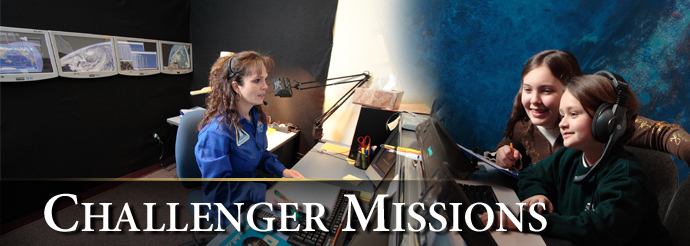
Anniversary Marks Start of Lasting Legacy
On Jan. 28, 2011, the Challenger Learning Center helped remember the reason the center came to be in the first place. That date marked the 25th anniversary of the space shuttle Challenger tragedy, in which seven astronauts lost their lives when the shuttle exploded shortly after launch on a cold Florida morning. The families of the seven astronauts, who included the first educator in space, Christa McAuliffe, later that year founded the Challenger Center for Space Science Education, its directive dedicated to continuing the educational spirit of the last Challenger mission by developing Challenger Learning Centers worldwide to engage students in science and mathematics education. The Challenger Learning Center here at Wheeling Jesuit University began in 1994 when the Erma Ora Byrd Center for Educational Technologies building opened.
Delivering the keynote address at the anniversary event was Jon McBride, the West Virginia astronaut who piloted Challenger himself in 1984 on the first mission using a seven-person crew. Also speaking at the event were three of the Rocket Boys, the West Virginians immortalized in the book, The Rocket Boys, and the movie, October Sky, about a group of teens whose experiments with homemade rockets earned first prize in national science fair and propelled them into distinguished careers in science from their humble beginnings in a small mining town. Dr. Chuck Wood, director of the Center for Educational Technologies, discussed his role as chief of NASA's Space Shuttle Earth Observations Office at the time, which involved training the Challenger crew on making observations of the Earth during their time in space.
The event was a tremendous success with a packed house of invited guests and local dignitaries. Those visitors got to see the grand opening the new Micronauts facility for children 5 to 8 years old on the ground floor of the building. Wheeling is the only Challenger Center whose Micronauts program has its own exhibit hall. This colorful and vibrant exploratorium invites younger children—those in grades K-2—to experience a variety of hands-on activities that will spur their interest in science and math and the joy of learning.
Challenger flies missions both on site at its simulated space station and mission control and also reaching audiences worldwide through videoconferencing thanks to the e-Missions program. Challenger reached its 15th country in 2011 via e-Missions.
In 2011 Challenger made 921 video connections to classrooms around the world. That translates into more than 20,000 students reached through e-Missions. Adding in the onsite missions, Challenger reached more than 30,000 students in 2011, giving those students a chance to use their problem-solving skills and math and science abilities to work their way through a scenario fraught with crises.
You don't have to be a youngster to enjoy the Challenger Learning Center, though. The center's on-site and distance learning e-Missions are aimed at students in middle school, but many of the missions work just as well for older students. And adult missions for corporate events continue to be popular team-building events.
Another highlight in 2011 was the unveiling of a new website for the Challenger Learning Center. The new site offers information about all the missions the center can fly. Other features include news from and about the center, information about the summer camp program, and video showing missions in action. And of course, what organization is complete in 2011 without its own Facebook page. The Challenger Learning Center debuted its page as well.
